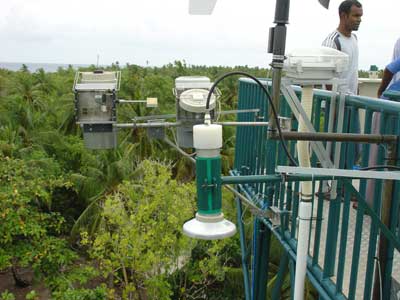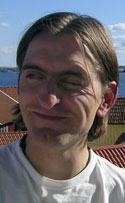SWEDISH SOUTH ASIAN STUDIES NETWORK
Department of Meteorology (MISU), Stockholm University
Address: Svante Arrhenius väg 12, Stockholm University,
SE-106 91 Stockholm, Sweden
Fax: +46-8-157185
Web page MISU: http://www.misu.su.se/
 Contact
person: Professor Emeritus Henning Rodhe,
phone: +46-8-164342. Also Director of the International Meteorological Institute (IMI). Personal web page.
Contact
person: Professor Emeritus Henning Rodhe,
phone: +46-8-164342. Also Director of the International Meteorological Institute (IMI). Personal web page.
The research at MISU covers a wide range of topics in atmospheric science and oceanography. With research efforts ranging from the depth of the oceans to the Earth's middle atmosphere, scientific diversity is a major strength of the department.
Research connected to South Asia
 |
| Observation post at Hanimadhoo, 220 km from Malé in the north Maldives. |
Since 2005 the Department of Meteorology at Stockholm University
is involved in a major research project on ”Characterization
of Light Absorbing Particulate Matter in Air and Precipitation over Southern
Asia”. This project, funded for 5 years by a US$
3.2 million grant from the Swedish International Development Cooperation
Agency (Sida), is part of the much larger International ”Atmospheric
Brown Cloud (ABC)” programme dealing with the problem of
air pollution in the Indo-Asia Pacific Region, and its impact on climate
and the environment. Prof. Henning Rodhe
and Prof. Caroline
Leck lead the research group at MISU, and they have been assisted
by Resarch Scientist Erik Engström
and three technicians. Close liaison is also upheld with Prof. Jost Heintzenberg’s
Institute for Tropospheric Research in Leipzig, Germany.
More information on the ABC research project at MISU.
More information on the International
Atmospheric Brown Clouds project (ABC)
The International programme is coordinated by the Regional Resource Centre for Asia and the Pacific (RRC.AP) of the United Nations Environment Programme (UNEP), based in Bangkok, but it involves several research institutions in America, Asia and Europa besides MISU. The research institutions in South Asia that are involved in this project are TERI, the Energy and Resources Institute in New Delhi, and the National Physical Laboratory, New Delhi.
The researchers at MISU aims at getting a better understanding of the atmospheric life cycle of soot and its climate effects. Optical and chemical properties of soot particles in air and precipitation will be investigated by means of spectral light absorption, Raman scattering, electron microscopy and chemical multi-component analyses. MISU contributes to the International program by performing measurements at four stations in the South Asian region, located at Godavari, about 10 km south of Kathmandu in Nepal; at Sinhagad near Pune in western India; Nadan, Kanan near Bhubaneswar in Orissa; and at Hanimadhoo, 220 km from Malé in the north Maldives. MISU will install and operate the measurement equipment for these four ABC sites. The program also includes a capacity building component with at least one PhD student from Asia and several extended visits (at the post doc level) by Asian scientists to Stockholm and Swedish scientists to Asia.
The research group at MISU earlier, in the late 1990s took
an active part in the Indian Ocean International
Field Experiment project (INDOEX) from 1995 till 1999, involving
a large number of researchers and institutions in Europe, America, Asia
and Africa. This project related to the issue of human influence on global
climate, and the complex influence of aerosol cooling on global warming.
Field studies were conducted in the Indian Ocean area from the Antarctica
in the south to the Indian subcontinent, and the project's goal was to
study natural and anthropogenic climate forcing by aerosols and feedbacks
on regional and global climate. More
information on the INDOEX project.
The MISU researchers, led by Prof. Henning Rodhe
and Docent Lennart Granat, worked on rainwater
samples for chemical analysis, collected over the Indian Ocean in early
1999, on board the research vessels Ronald H. Brown and Sagar Kanya. The
results showed that the concentrations of sulfur, nitrogen and crustal
components over the Indian Ocean, already then were clearly influenced
by pollution and soil sources in Asia, not the least by soot – the
“dark horse” in the present climate debate.
In recent years MISU has been involved in another project called Regional Air Pollution in Developing Countries (RAPIDC), also funded by Sida. It was carried out in collaboration with Asian scientists in studies of the ionic composition of aerosol particles and rainwater.
Collaboration partners in South Asia:
The Indian Institute of Tropical Meteorology, Pune, India
Indian Institute of Chemical Technology, Hyderabad, India
International Centre for Integrated Mountain Development (ICIMOD), Kathmandu, Nepal
 Erik Engström has been involved in the ABC research project (see above) as a PhD candidate from 2005. Personal web page.
Erik Engström has been involved in the ABC research project (see above) as a PhD candidate from 2005. Personal web page.
On 27 November 2009, he defended his doctoral dissertation entitled ”Characterization of light absorbing particulate matter in air and precipitation over Southern Asia”. The faculty opponent was Prof. Paolo
Laj from Université Blaise Pascal in Clermont-Ferrand, France. The thesis is based on filter-based optical measurements of soot – light absorbing particulate matter at a wavelength of about 550 nm – in air and rainwater. The research work was performed between June 2005 to and May 2009, at Godavari in Nepal; Sinhagad in India; and Hanimaadhoo in the Maldives. A method for determination of water-insoluble light absorbing matter inrainwater was developed. Read the full abstract. ![]()
2008 UNEP Report
 In collaboration with Dr. Örjan Gustafsson at the Applied Environmental Science (ITM), Stockholm University and several other European, American and Asian researchers, Prof. Rodhe published an article in Science Magazine volume 323, January 2009. The article is titled ”Brown Clouds over South Asia: Biomass or Fossil Fuel Combustion?”. It deals with the haze and smog that is prevalent in urban areas of India under specific humidity conditions associated with winter monsoon period during which there is no rain to wash pollutants from the air. The brown clouds are created by a range of airborne particles and pollutants from combustion (e.g. woodfires, cars, and factories), biomass burning and industrial processes with incomplete burning. The scientists have now proved that most of it is actually caused by wodfire and biomass burning, and less can be attributed to fossil burning. More information on the Science article (in Swedish)
In collaboration with Dr. Örjan Gustafsson at the Applied Environmental Science (ITM), Stockholm University and several other European, American and Asian researchers, Prof. Rodhe published an article in Science Magazine volume 323, January 2009. The article is titled ”Brown Clouds over South Asia: Biomass or Fossil Fuel Combustion?”. It deals with the haze and smog that is prevalent in urban areas of India under specific humidity conditions associated with winter monsoon period during which there is no rain to wash pollutants from the air. The brown clouds are created by a range of airborne particles and pollutants from combustion (e.g. woodfires, cars, and factories), biomass burning and industrial processes with incomplete burning. The scientists have now proved that most of it is actually caused by wodfire and biomass burning, and less can be attributed to fossil burning. More information on the Science article (in Swedish) ![]()
The article is based on an extensive report titled ”Atmospheric Brown Clouds: Regional Assessment Report with Focus on Asia” that was presented in 2008 by the United Nations Environment Programme (UNEP),
Regional Resource Center for Asia and the Pacific. The report was prepared by
the Agriculture Impact Study Group coordinated by the Indian Agricultural Research Institute
(IARI, India) and the Center for Clouds Chemistry and Climate of the Scripps Institution of
Oceanography (SIO), USA; Water Impact Study Group coordinated by Nanyang Technological
University (NTU), Singapore; and Health Impact Study Group Coordinated by Chulabhorn
Research Institute (CRI), Thailand in coordination with the ABC Science Team.
The lead authors behind the report include Veerabhadran Ramanathan, University of California San Diego, USA; Henning Rodhe, Stockholm University,
Sweden; Madhoolika Agrawal, Banaras Hindu University (BHU), Varanasi, India; Usha Kiran Chopra and A.K. Singh from the Indian Agriculture Research Institute, India; Lisa Emberson, Stockholm Environment Institute, UK; Syed Iqbal Hasnain, The Energy and Resources Institute (TERI), India; Mylvakanam Iyngararasan, United Nations
Environment Programme; and Achuthan Jayaraman, National Atmospheric Research Laboratory, India. Full information about the report. ![]()
SASNET - Swedish South Asian Studies Network/Lund
University
Address: Scheelevägen 15 D, SE-223 70 Lund, Sweden
Phone: +46 46 222 73 40
Webmaster: Lars Eklund
Last updated
2011-02-23
